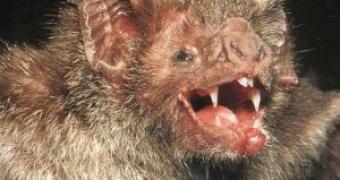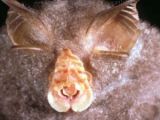Bats are not only the solely flying mammals, but the most diverse also, after rodents.
There are the so-called Megachiroptera ("big bats", flying foxes and relatives) and Microchiroptera ("small bats", typical bats) (do not be fooled, some flying foxes also can be small, while some "small bats" can be quite goodly).
Microchiroptera are much more diverse and diversified, not to mention that their echolocation apparatus is much more sophisticated and complex. During their nocturnal flight, bats rely on the echoes of their ultrasonic calls to orientate: practically they "see" (get a tridimensional image of the environment) through their ears! This technique is named echolocation (biosonar).
Amongst Microchiroptera, there are two evolutionary groups, the leaf nosed (photo center: Centurio senex) (in Americas; this group encompasses the infamous vampire bats - photo above) and the horseshoe bats (in the Old World) (photo bellow), that possess extremely complicated patterns of creases, flaps, wrinkles and grooves around the nostrils dubbed "noseleaves" or "horseshoe".
These complex facial masks make bats famous in the gallery of ugliness! From roughly 1,100 bat species, most emit ultrasounds through their mouths, but about 300 species do it through their noses. Interestingly enough, and adding to the puzzle, these micro-bats have ears smaller and less sophisticated than other micro-bats...
Scientists have long supposed these facial masks might improve bat sonar, but they were puzzled about their precise role until recently a team at Shandong University in Jinan, China, found that these structures apparently could help focusing the bat's sonar. They generated a three-dimensional computer model of the facial masks of the rufous horseshoe bat (Rinolophus rouxi) using X-ray scans. Then, the researchers simulated how ultrasound emitted by the bats interact with the nose flaps.
The bats sent ultrasounds that started at about 60 kilohertz, quickly rose to a constant frequency of roughly 80 kHz, and then returned to 60 kHz. "Computer simulations revealed horizontal furrows along the top of the noseleaves behaved as cavities that resonate strongly with certain frequencies of sound, just as blowing into "a set of clarinets," can produce deep, resonant tones," explained biologist turned computational physicist Rolf M?ller. The facial mask caused the different frequencies of sound to focus in different ways. The lower frequency 60 kHz sound spread vertically, while the 80 kHz sound focused ahead. "The noseleaves essentially help the bats make the most of the ultrasound they emit," said M?ller.
This helps the bat save energy expended with producing ultrasounds. "For the bat, sound energy is like money to us-we usually only have a limited amount of it and we must make a choice on how to distribute it," he said.
Thus, the flaps shape how the lower frequency sound "illuminates" the environment, while the other frequencies remain untouched and thus able to scan the world in different ways. The complexity of the facial apparatus helps "in performing difficult sonar tasks like navigating in complex environments such as dense forests or doing several things at once, such as looking for prey and avoiding obstacles," M?ller speculated. This sonar apparatus is so efficient, that horseshoe often detects pray while standing still on a perch. Facial masks are even found on bats which are not from leaf noses or horseshoe groups. "All facial structures seen in bats are now candidates for acoustic 'beam-shaping devices," M?ller said.
Likewise, "the outer ears of most bats also have intriguing shape features," M?ller said. "These features could act in similar ways as the noseleaves."
This discovery could help scientists improve sonar and radio technology, by developing sensory technology that is less expensive and more adaptable to its surroundings. "The goal of this research is to not only better understand how bat echolocation works, but to apply the principles to improving antenna technology, for use in sonar, non invasive biomedical or commercial scanners and wireless communication," M?ller said.
"Right now you need lots of different antennas and signals, and that starts to get expensive. But if we could mimic the bat, we would not need so many antennas and signals. Some communication functions would be less expensive."
"Unlike our current technical systems," explains M?ller, "bats have much more freedom of choice in where to listen. It's like having a flashlight that you can shine where you would like. The bats can also change the shape they are using, to make it an ellipse instead of a circle. It's like being able to do more than just make a circle bigger or smaller by moving the flashlight. You change the shape the light makes."

 14 DAY TRIAL //
14 DAY TRIAL // 

